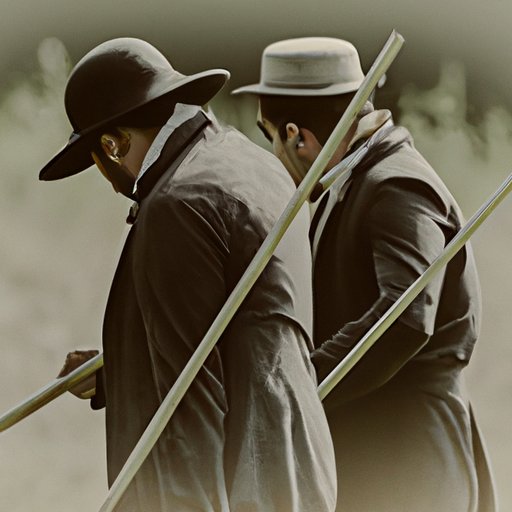Exploring Trench Warfare: Life in the Muddy Trenches of World War I
When we think of World War I, images of muddy, trench-filled battlefields come to mind. Trench warfare, a military tactic that dominated the conflict from 1914-1918, was unlike any form of warfare ever seen before. As soldiers dug and lived in trenches for months on end, this brutal and inhumane way of fighting changed the course of history forever. In this article, we’ll explore the life of a trench warfare soldier, the tactics and strategies used, and its impact on the war and modern warfare.
Historical Overview
The First World War (1914-1918) was characterized by a new kind of warfare where both sides dug deep trenches to defend their territory. The main causes of trench warfare were the heavy casualties in early battles, the defensive power of the new weapons such as the machine gun, and difficulties in coordinating an attack over long distances.
The most devastating battles of trench warfare were fought on the Western Front in Europe, including the Battle of Verdun and the Somme Offensive, as well as battles in the Middle East and Asia. Both sides used a variety of tactics, including mining, trench raids, and artillery bombardment, in order to gain ground and break the stalemate.
Life in the Trenches
The living conditions in the trenches were nothing short of horrific. Trenches were constantly wet, muddy, and infested with rats and lice. Soldiers had very little protection from the harsh weather and were often exposed to cold and rain for days on end.
Food was often scarce and of poor quality, and soldiers resorted to eating anything they could find, including rats and bugs. Sanitation was nonexistent and disease ran rampant, leading to many soldiers being hospitalized or dying from illnesses such as trench foot and dysentery. However, the mental impact of trench warfare on soldiers was equally devastating.
Soldiers were constantly in fear of being killed in battle or by artillery shelling during downtime, leading to what is now known as shell shock and PTSD. The constant sound of artillery and the sight of dead or wounded soldiers had a profound psychological effect on soldiers, some of whom developed severe emotional disorders that would last for the rest of their lives.
Technological Advances and Trench Warfare
New technological advances such as machine guns, tanks, and poison gas had a significant impact on trench warfare. Poison gas was first used at Ypres in 1915 and quickly became a standard weapon used by both sides.
Tanks were first deployed at the Battle of the Somme in 1916, but their effectiveness was limited due to their slow speed and the difficulty of maneuvering them in the trenches. Machine guns, on the other hand, were a game-changer in trench warfare, enabling soldiers to hold off large advances and kill enemies from afar.
Human Cost of Trench Warfare
The human cost of trench warfare was staggering. Millions of soldiers and civilians lost their lives in battles fought in trenches across the globe. The emotional toll on soldiers and their families was also burdensome.
Due to censorship and government propaganda, many civilians were unaware of the true horrors of trench warfare, leading to disillusionment, depression, and social unrest after the war. The legacy of trench warfare is characterized by loss and suffering.
Military Strategy of Trench Warfare
Military strategy during trench warfare was characterized by offensive and defensive tactics. Offensive tactics involved tunneling under enemy trenches, artillery bombardment, and massive infantry attacks. Defensive tactics involved the use of machine guns and barbed wire to protect trench lines.
Although trench warfare was a relatively effective defensive strategy, it proved to be a disastrous offensive strategy. By 1917, soldiers on both sides were disillusioned with the lack of progress in the war and many began to question their leaders and the government. This resulted in social unrest and revolution which ultimately led to the end of the war in 1918, with the signing of the Treaty of Versailles.
Trench Warfare and Modern Warfare
The experience of trench warfare had a profound impact on the development of modern warfare. Military strategists found that trench warfare was too limited and too costly in terms of life and resources, leading to the development of new tactics and weapons.
The lesson learned from the Great War was that there had to be a better way to wage war. The horrors of trench warfare led to the development of new technologies such as aerial threats, e-warfare, and instant communication. These developments changed the face of war and made it a new kind of hell.
Gender and Trench Warfare
The role of women during trench warfare was mainly in the medical field, where they served as nurses and support staff for injured soldiers. Women also worked in factories, supplying troops with weapons and ammunition.
Gender norms at the time dictated that women should not participate in battle, and it was not until World War II that women began to be more involved in combat. However, women played a vital role in supporting the soldiers of trench warfare, often putting their own lives on the line to save the lives of others.
Conclusion
In conclusion, trench warfare was an inhumane and brutal way of fighting that had a profound impact on soldiers, civilians, and society as a whole. The legacy of trench warfare has shaped the way we think about war and the development of new technologies, tactics, and strategies. Today, we remember the human cost of trench warfare and the sacrifices made by so many brave soldiers during World War I.
